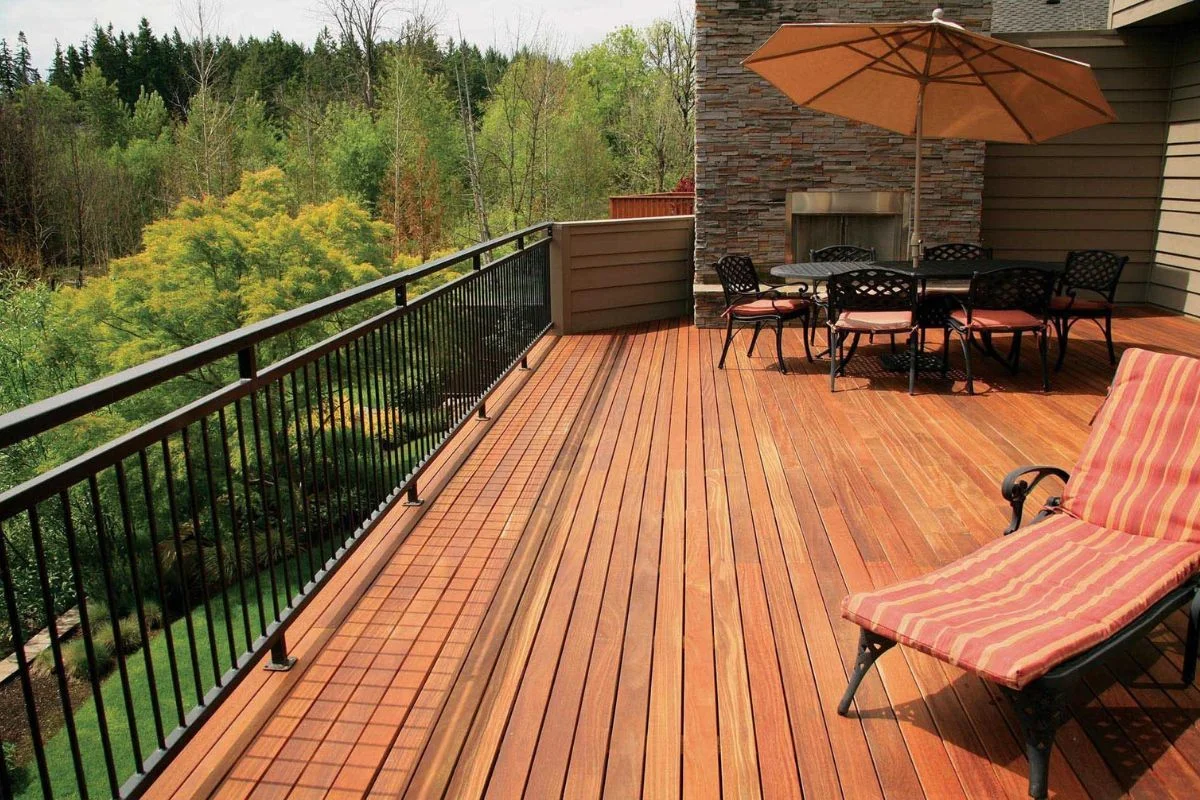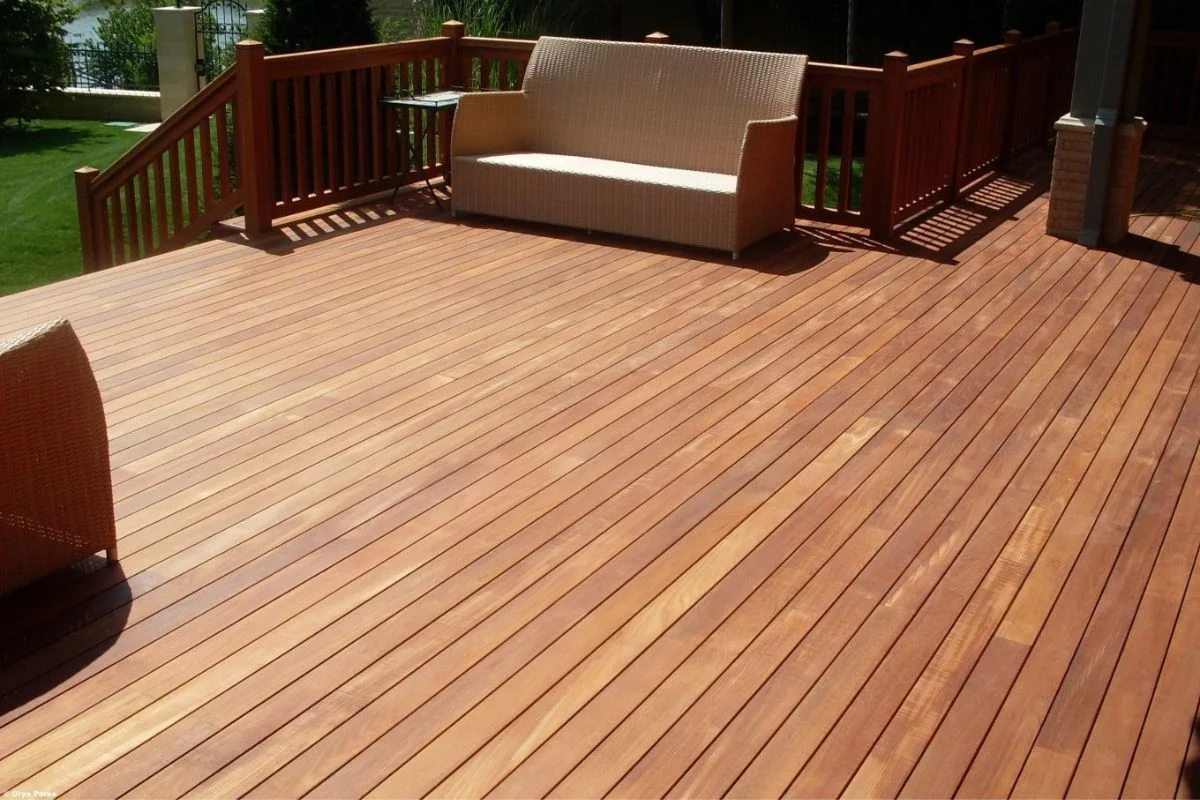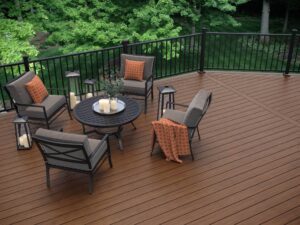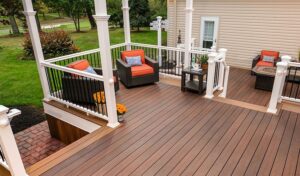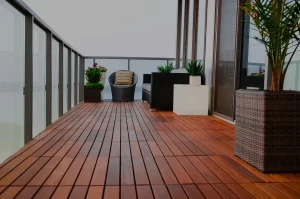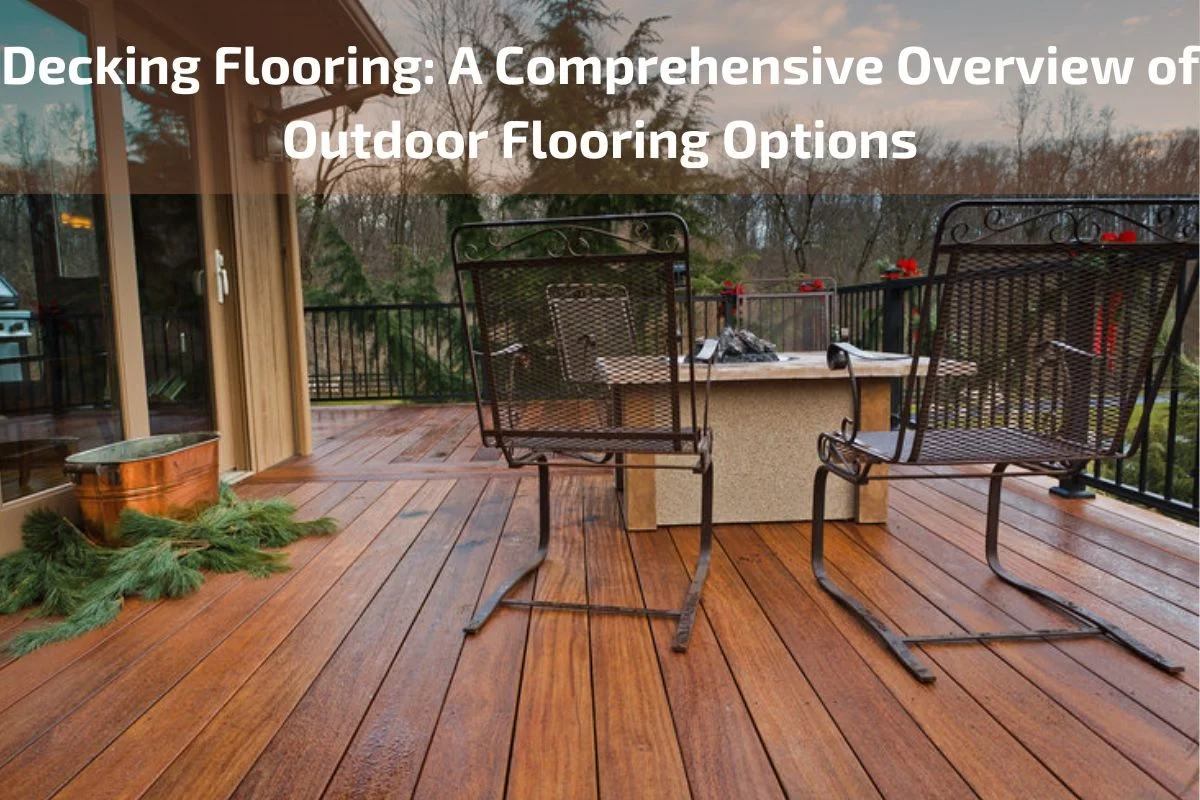
Decking flooring serves as the foundation for outdoor spaces, providing both functionality and aesthetic appeal. Whether you’re creating a cozy backyard retreat, a spacious patio for entertaining, or a tranquil deck overlooking scenic views, the choice of flooring can significantly impact the overall look and feel of your outdoor area.
In this comprehensive guide, we’ll explore the world of decking flooring, offering an overview of the various options available for outdoor spaces. From traditional wood decking to modern composite materials and innovative alternatives, we’ll delve into the characteristics, advantages, and considerations of each flooring option.
Importance of decking flooring in outdoor spaces
Decking flooring plays a crucial role in outdoor spaces, offering both practical and aesthetic benefits that enhance the overall functionality and appearance of the area. Here are some key reasons highlighting the importance of decking flooring:
Enhanced Outdoor Living: Decking flooring provides a designated area for outdoor living, whether it’s for lounging, dining, or entertaining guests. By creating a stable and level surface, decking flooring extends the usable space of a property, allowing homeowners to fully enjoy their outdoor environment.
Versatility in Design: Decking flooring comes in various materials, colors, and styles, offering homeowners the flexibility to customize their outdoor space according to their preferences and design aesthetic. Whether opting for traditional wood decking or modern composite materials, the versatility of decking flooring allows for endless design possibilities.
Increased Property Value: Well-designed and properly maintained decking flooring can significantly enhance the curb appeal and resale value of a property. A visually appealing outdoor space with quality decking flooring can attract potential buyers and contribute to a higher perceived value of the property.
Durability and Longevity: High-quality decking flooring materials are known for their durability and longevity, with the ability to withstand outdoor elements such as sunlight, moisture, and temperature fluctuations. Properly installed and maintained decking flooring can last for many years, providing a reliable outdoor surface for various activities.
Safety and Accessibility: Decking flooring provides a safe and accessible surface for outdoor activities, such as walking, playing, and socializing. Unlike uneven or unpaved surfaces, decking flooring offers a stable and slip-resistant footing, reducing the risk of accidents and injuries, especially in high-traffic areas.
Low Maintenance Requirements: Compared to other outdoor flooring options, decking flooring typically requires minimal maintenance to keep it looking its best. Regular cleaning and occasional treatments are usually sufficient to preserve the appearance and integrity of decking flooring, making it a practical choice for homeowners with busy lifestyles.
Advantages of Decking Flooring:
Decking flooring offers several advantages that make it a popular choice for outdoor spaces:
Aesthetic Appeal: Decking flooring adds a touch of natural beauty to outdoor areas with its rich texture and warm tones, enhancing the overall appearance of the space.
Durability: Most decking materials, such as treated wood, composite, or PVC, are designed to withstand harsh weather conditions, heavy foot traffic, and frequent use without deteriorating quickly.
Low Maintenance: Compared to other outdoor flooring options, decking requires minimal upkeep. Regular cleaning and occasional sealing or staining are typically all that’s needed to keep it looking great for years.
Versatility: Decking flooring can be installed in various configurations and patterns, allowing for creative design possibilities to suit different preferences and outdoor layouts.
Safety: The textured surface of decking provides better traction, reducing the risk of slips and falls, especially when the surface is wet.
Longevity: Properly installed and maintained decking can last for decades, providing a long-term investment in the value and functionality of outdoor living spaces.
Environmental Friendliness: Some decking materials, such as composite decking made from recycled plastics and wood fibers, offer eco-friendly alternatives to traditional wood decking, reducing the need for virgin materials and minimizing environmental impact.
Increased Property Value: Well-designed and maintained decking can enhance the curb appeal and market value of a property, making it a desirable feature for potential buyers or renters.
Disadvantages of Decking Flooring
While decking flooring offers many benefits, it also comes with some potential drawbacks to consider:
Initial Cost: The upfront cost of materials and installation for decking flooring can be higher compared to other outdoor flooring options like concrete or gravel.
Maintenance Requirements: Despite being low-maintenance relative to some alternatives, decking still requires periodic cleaning, sealing, and possibly staining or painting to maintain its appearance and structural integrity.
Prone to Damage: Depending on the material used, decking flooring may be susceptible to damage from factors such as moisture, insects, mold, and rot, especially if not properly maintained or if installed in a location with high humidity or frequent exposure to water.
Fading and Discoloration: Over time, exposure to sunlight and weathering can cause decking materials to fade or change color, requiring regular treatments or replacements to maintain a consistent appearance.
Slippery Surface: While the texture of decking provides traction in dry conditions, it can become slippery when wet, posing a safety hazard, especially around swimming pools or in areas prone to rain or snow.
Potential for Splinters: Wood decking, in particular, can develop splinters over time, which may pose a risk of injury, especially for bare feet or pets.
Limited Lifespan: Despite its durability, decking flooring may have a finite lifespan, especially in harsh climates or environments with extreme temperature fluctuations, requiring eventual replacement or refurbishment.
Environmental Concerns: While some decking materials are eco-friendly, others, especially those made from chemically treated wood or non-recyclable plastics, can have negative environmental impacts during production, use, and disposal.
Susceptibility to Warping or Cupping: Wood decking is prone to warping, cupping, or twisting over time, particularly if not properly installed or if exposed to moisture unevenly.
Types of Decking Flooring Materials:
Several types of materials are commonly used for decking flooring, each offering unique characteristics and benefits:
- Pressure-Treated Wood:
- Description: Pressure-treated wood, typically made from Southern Yellow Pine, is infused with chemicals to enhance its resistance to decay, insects, and rot.
- Advantages: Affordable, readily available, and easy to work with. Offers natural wood aesthetics and can be stained or painted to match various styles.
- Disadvantages: Requires regular maintenance, such as sealing and staining, to prolong lifespan and prevent warping or cracking. Chemical treatment may raise environmental concerns.
- Cedar:
- Description: Cedar decking is prized for its natural resistance to decay, insects, and moisture, making it a popular choice for outdoor applications.
- Advantages: Naturally durable, with a distinct aroma and attractive grain patterns. Requires less maintenance than pressure-treated wood.
- Disadvantages: Higher initial cost compared to pressure-treated wood. Can still warp or degrade over time if not properly maintained.
- Composite Decking:
- Description: Composite decking is made from a blend of recycled wood fibers and plastic, typically polyethylene or PVC.
- Advantages: Low-maintenance, durable, and resistant to rot, mold, and insect damage. Available in a wide range of colors and textures, often mimicking the look of natural wood.
- Disadvantages: Higher upfront cost than wood decking. Some composite materials may be prone to scratching, fading, or staining over time. Installation may require specialized tools and techniques.
- Tropical Hardwoods:
- Description: Tropical hardwoods, such as Ipe, Cumaru, and Tigerwood, are dense, exotic woods known for their exceptional durability and natural resistance to decay and insects.
- Advantages: Extremely durable and long-lasting, with striking grain patterns and rich colors. Requires minimal maintenance and can last for decades.
- Disadvantages: Considerably higher cost than other decking materials. Harder to source and may require special handling and installation techniques due to their density.
- PVC (Polyvinyl Chloride) Decking:
- Description: PVC decking is made entirely of synthetic materials, offering exceptional resistance to moisture, mold, and mildew.
- Advantages: Highly durable, low-maintenance, and impervious to moisture, stains, and scratches. Available in a variety of colors and textures.
- Disadvantages: Generally more expensive than wood or composite decking. Can be susceptible to fading or discoloration over time, especially in extreme sunlight. Limited availability of natural wood aesthetics.
Decking Flooring vs. Other Outdoor Flooring Options
Comparing decking flooring to other outdoor flooring options can help in understanding their respective advantages and disadvantages:
Concrete:
- Advantages: Concrete is durable, low-maintenance, and versatile. It can be poured in various shapes and finishes, offering design flexibility. It’s also relatively affordable compared to some decking materials.
- Disadvantages: Concrete can crack over time, especially in areas with freezing temperatures. It lacks the warmth and natural aesthetics of decking and may require sealing to prevent staining.
Gravel:
- Advantages: Gravel is inexpensive, easy to install, and allows for good drainage. It’s also versatile and can be used in various outdoor settings, including pathways and patios.
- Disadvantages: Gravel can shift and become uneven, requiring periodic leveling and maintenance. It may also pose challenges for mobility devices and furniture with small legs.
Brick or Pavers:
- Advantages: Brick or paver flooring offers durability, aesthetic appeal, and a wide range of design options. It can withstand heavy use and is relatively low-maintenance.
- Disadvantages: Installation can be labor-intensive, and individual bricks or pavers may become loose or settle over time, requiring occasional adjustments. It’s also more expensive than some other options.
Natural Stone:
- Advantages: Natural stone, such as slate, limestone, or travertine, provides a luxurious and timeless look. It’s durable, heat-resistant, and available in various colors and textures.
- Disadvantages: Natural stone can be costly to purchase and install. It may also require sealing to prevent staining and can be slippery when wet, posing a safety hazard.
Synthetic Turf:
- Advantages: Synthetic turf offers a low-maintenance alternative to natural grass, providing a green, soft surface year-round. It’s suitable for various outdoor activities and requires minimal watering and upkeep.
- Disadvantages: Synthetic turf can become hot in direct sunlight, may have a shorter lifespan than other options, and can be challenging to clean thoroughly.
Maintaining Decking Flooring
Maintaining decking flooring is essential to preserve its appearance, structural integrity, and longevity. Here are some key maintenance tasks to consider:
Regular Cleaning: Sweep the decking surface regularly to remove dirt, leaves, and debris. Use a mild detergent and water solution to scrub the surface with a soft-bristle brush or mop. Rinse thoroughly with water afterward.
Preventive Measures: Place mats or rugs in high-traffic areas to minimize wear and tear. Use coasters or protective pads under furniture legs to prevent scratching or indentations on the decking surface.
Inspect for Damage: Periodically inspect the decking for signs of damage, such as cracks, splinters, or loose boards. Repair or replace damaged boards promptly to prevent further deterioration.
Sealing or Staining: Depending on the material used, consider applying a sealant or stain to protect the decking from moisture, UV rays, and other environmental factors. Follow manufacturer recommendations for application frequency and technique.
Trim Vegetation: Trim overhanging branches and vegetation near the decking to prevent debris buildup, moisture retention, and potential damage from roots or pests.
Prevent Mold and Mildew: Ensure proper ventilation and drainage to prevent the buildup of moisture, which can promote mold and mildew growth. Clean mold and mildew promptly using a solution of water and mild detergent or a commercial cleaner formulated for outdoor surfaces.
Remove Stains: Promptly clean up spills to prevent staining. For stubborn stains, use a specialized deck cleaner or a solution of oxygen bleach and water. Avoid using harsh chemicals or abrasive cleaners that could damage the decking surface.
Check Hardware: Inspect and tighten any screws, nails, or fasteners used to secure the decking boards. Replace any corroded or damaged hardware as needed to maintain structural integrity.
Winter Maintenance: In regions with freezing temperatures, remove snow and ice promptly to prevent moisture damage and slipping hazards. Avoid using metal shovels or sharp objects that could scratch or gouge the decking surface.
Professional Inspection: Consider scheduling a professional inspection and maintenance service annually to identify any potential issues and ensure the decking remains in optimal condition.
Conclusion
In conclusion, decking flooring offers numerous benefits for outdoor spaces, including aesthetic appeal, durability, and versatility. However, it’s essential to weigh these advantages against potential drawbacks and consider alternative outdoor flooring options based on individual needs and preferences.

